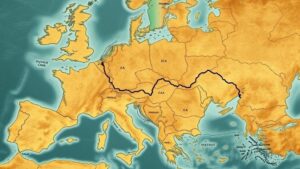Using Magnetic Variation Data to Predict Artifact Locations in Iron-Rich Areas
Using Magnetic Variation Data to Predict Artifact Locations in Iron-Rich Areas
The intersection of archaeology and geo-magnetism provides a unique opportunity for enhancing artifact location predictions, especially in iron-rich areas where magnetic variation can significantly influence detection methodologies. This article delves into the application of magnetic variation data, supported by case studies and scientific principles, to enhance our understanding of subsurface archaeological remains in such areas.
Understanding Magnetic Variation
Magnetic variation, also known as magnetic declination, is the angle between magnetic north and true north. This phenomenon is not constant and varies based on geographical location and time due to changes in the Earths magnetic field. Understanding these variations is crucial for effectively utilizing magnetometry in archaeological surveys.
The magnetic field on Earth can be represented in a model known as the International Geomagnetic Reference Field (IGRF), which provides data on expected magnetic variations across different regions. By applying this model, archaeologists can adjust their data collection methods to identify significant anomalies that may indicate the presence of artifacts.
The Role of Iron-Rich Substrates
Iron-rich areas, characterized by substantial concentrations of ferromagnetic materials, present unique challenges and opportunities for archaeological endeavors. These substrates can distort magnetic readings, making it difficult to discern anthropogenic artifacts from natural geological deposits. But, the same properties that complicate analysis also offer a distinctive advantage in artifact localization.
For example, archaeological sites with iron tools or ceremonial objects will produce higher magnetic signatures than the surrounding soil. By documenting and understanding the local magnetic variation, archaeologists can refine their search algorithms to locate these anomalies more precisely.
Using Magnetic Variation Data in Field Surveys
Field surveys utilizing magnetometry often rely on the difference between expected baseline magnetic fields (as given by IGRF) and the measured field. This method allows for the identification of anomalies indicative of buried artifacts. process typically involves the following steps:
- Mapping the baseline magnetic field of the area using magnetometers.
- Comparing measured variations against the expected baseline.
- Isolating anomalies that suggest potential artifact locations.
For example, a project undertaken in the American Midwest by the University of Chicago involved the surveying of prehistoric agricultural sites using detailed magnetic mapping. The team observed notable magnetic increases correlating with historical habitation areas, allowing them to pinpoint digging locations with a high likelihood of artifact discovery.
Case Study: The Fort St. Joseph Archaeological Project
The Fort St. Joseph Archaeological Project, located in Michigan, serves as an exemplary case for demonstrating the effective use of magnetic variation data in artifact location prediction. The site, previously a French Jesuit mission and later a British fort, is rich in iron artifacts traditionally difficult to locate due to the iron-rich substratum of the area.
By employing a combination of high-precision magnetometry and geomagnetic modeling, the research team identified several anomalies correlating with historical documentation of the forts layout. Subsequent excavations confirmed findings, unveiling storage pits and hearths previously obscured by magnetic interference.
Challenges and Limitations
Despite the benefits, the use of magnetic variation data is not without its challenges. following limitations should be considered:
- Geological variations can cause misleading readings; factors such as soil moisture can also influence magnetic susceptibility.
- New artifacts or modern metal debris can create false positives, complicating interpretation.
- The need for continual calibration of instruments to account for temporal changes in the magnetic field.
Understanding these challenges is essential for researchers intending to leverage magnetic variation data effectively. Useing advanced data processing techniques and integrating other archaeological methods, such as ground-penetrating radar (GPR), can mitigate some of these challenges.
Actionable Takeaways
The integration of magnetic variation data in archaeological surveys, particularly in iron-rich areas, offers an innovative approach to predicting artifact locations. Key actionable takeaways for practitioners include:
- Utilizing the IGRF model to establish baseline magnetic fields tailored to specific geographical contexts.
- Adopting a multi-methodological approach by combining magnetometry with other geophysical techniques for more comprehensive data analysis.
- Engaging in continuous training and calibration of equipment to enhance data accuracy and reliability.
By embracing these strategies, archaeologists can better navigate the complexities associated with iron-rich terrains, leading to more effective artifact recovery and a deeper understanding of historical contexts.



